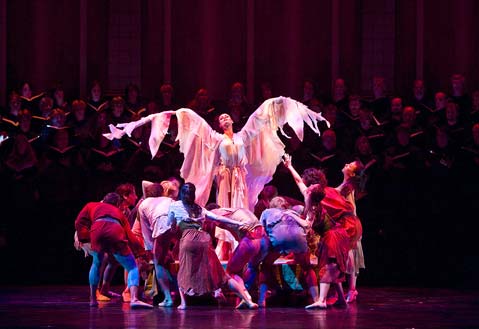An Historic Occasion
Carmina Burana. At the Granada Theatre, Saturday, May 31.

This majestic production was the fruit of many months’ labor on the part of more than 200 people, and showed what heights can be reached when community groups join forces. Along with a professional orchestra assembled for the occasion and three superb vocal soloists, the Santa Barbara Choral Society and State Street Ballet created a lively, coherent, and wholly satisfying new version of Carl Orff’s Carmina Burana. With the chorus standing on risers behind the dance stage and the orchestra below in the Granada’s amazing adjustable pit, the stage proper became a dream space in between-the perfect location for the unfolding of William Soleau’s world premiere choreography.
The curtain was emblazoned with Fortune’s wheel, the core symbol of the piece, and it rose to reveal a group of standing pillars. As the familiar strains of the “Fortuna Imperiatrix Mundi” rang through the Granada, these pillars converted into benches, then tables, and then ladders, while the honeycomb-shapes they supported became headdresses. As Fortune, dancer Maria Fliagina stood in the center while her giant dress was first wafted and spun like a parachute, then made to fly away up over her head like a ghost.
Soleau’s choreography succeeded in depicting medieval life through various tableaus, using simple costumes and complex compositions to achieve the density and realism of a Breughel painting. At the same time, the dancers’ constant movement unsettled this vision and called into question the solidity and permanence of any single view of the world. Throughout the performance, couples would frolic and change partners in cycles that were at once as ordered as the seasons and as chaotic as the weather. All the dancers were marvelous, yet Sarah Fuhrman and Spencer Gavin as the couple, and company members Leila Drake, Alyson Mattoon, Victoria Luchkina, Bayaraa Badamsambuu, and Ryan Camou, stood out for the great energy and vivaciousness they brought to their many changing roles.
The vocal soloists each faced extreme challenges, and together they carried them off well. Beau Palmer, who also appeared in the warm-up act’s Chichester Psalms, showed masterful control as he negotiated the sudden shifts between tenor and counter-tenor that Orff wrote into his part. Baritone Paul Sahuc held up well under similar unorthodox demands, and soprano Lori Stinson brought down the house with her highly theatrical renderings of “Stetit puella” and especially “In trutina.” Congratulations to everyone involved on this historic achievement.



